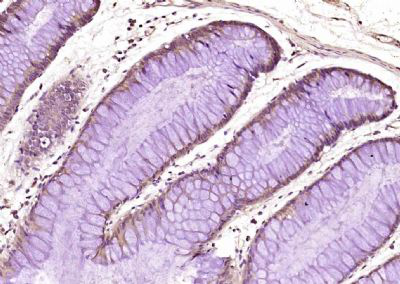产品货号 : mlR9267
英文名称 : USP10
中文名称 : 去泛素酶10抗体
别 名 : Deubiquitinating enzyme 10; Ubiquitin carboxyl terminal hydrolase 10; Ubiquitin carboxyl-terminal hydrolase 10; Ubiquitin specific peptidase 10; Ubiquitin specific processing protease 10; Ubiquitin specific protease 10; Ubiquitin thioesterase 10; Ubiquitin thiolesterase 10; Ubiquitin-specific-processing protease 10; UBP10_HUMAN; UBPO; USP 10; USP10.
研究领域 : 肿瘤 细胞生物 表观遗传学
抗体来源 : Rabbit
克隆类型 : Polyclonal
交叉反应 : Human, Mouse, Rat, Chicken, Dog, Pig, Horse, Rabbit,
产品应用 : ELISA=1:500-1000 IHC-P=1:400-800 IHC-F=1:400-800 IF=1:50-200 (石蜡切片需做抗原修复)
not yet tested in other applications.
optimal dilutions/concentrations should be determined by the end user.
分 子 量 : 87kDa
细胞定位 : 细胞核 细胞浆
性 状 : Lyophilized or Liquid
浓 度 : 1mg/ml
免 疫 原 : KLH conjugated synthetic peptide derived from human USP10:461-560/798
亚 型 : IgG
纯化方法 : affinity purified by Protein A
储 存 液 : 0.01M TBS(pH7.4) with 1% BSA, 0.03% Proclin300 and 50% Glycerol.
保存条件 : Store at -20 °C for one year. Avoid repeated freeze/thaw cycles. The lyophilized antibody is stable at room temperature for at least one month and for greater than a year when kept at -20°C. When reconstituted in sterile pH 7.4 0.01M PBS or diluent of antibody the antibody is stable for at least two weeks at 2-4 °C.
PubMed : PubMed
产品介绍 : Ubiquitin is a highly conserved protein that is covalently linked to other proteins to regulate their function and degradation. This gene encodes a member of the ubiquitin-specific protease family of cysteine proteases. The enzyme specifically cleaves ubiquitin from ubiquitin-conjugated protein substrates. The protein is found in the nucleus and cytoplasm. It functions as a co-factor of the DNA-bound androgen receptor complex, and is inhibited by a protein in the Ras-GTPase pathway. The human genome contains several pseudogenes similar to this gene. Several transcript variants, some protein-coding and others not protein-coding, have been found for this gene. [provided by RefSeq, Jan 2013].
Function:
Hydrolase that can remove conjugated ubiquitin from target proteins such as p53/TP53, BECN1, SNX3 and CFTR. Acts as an essential regulator of p53/TP53 stability: in unstressed cells, specifically deubiquitinates p53/TP53 in the cytoplasm, leading to counteract MDM2 action and stabilize p53/TP53. Following DNA damage, translocates to the nucleus and deubiquitinates p53/TP53, leading to regulate the p53/TP53-dependent DNA damage response. Component of a regulatory loop that controls autophagy and p53/TP53 levels: mediates deubiquitination of BECN1, a key regulator of autophagy, leading to stabilize the PIK3C3/VPS34-containing complexes. In turn, PIK3C3/VPS34-containing complexes regulate USP10 stability, suggesting the existence of a regulatory system by which PIK3C3/VPS34-containing complexes regulate p53/TP53 protein levels via USP10 and USP13. Does not deubiquitinate MDM2. Deubiquitinates CFTR in early endosomes, enhancing its endocytic recycling.
Subunit:
Interacts with G3BP, which may regulate its function. Interacts with p53/TP53, SNX3 and CFTR.
Subcellular Location:
Cytoplasm. Nucleus. Early endosome. Note=Cytoplasmic in normal conditions. After DNA damage, translocates to the nucleus following phosphorylation by ATM.
Tissue Specificity:
Widely expressed.
Post-translational modifications:
Phosphorylated by ATM following DNA damage, leading to stablization and translocation it to the nucleus.
Ubiquitinated. Deubiquitinated by USP13.
Similarity:
Belongs to the peptidase C19 family. USP10 subfamily.
SWISS:
Q14694
Gene ID:
9100
Important Note:
This product as supplied is intended for research use only, not for use in human, therapeutic or diagnostic applications.
产品图片












